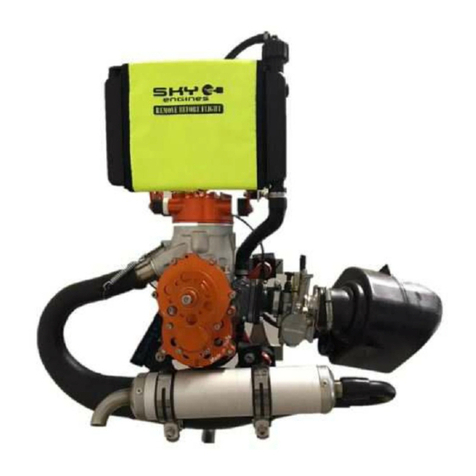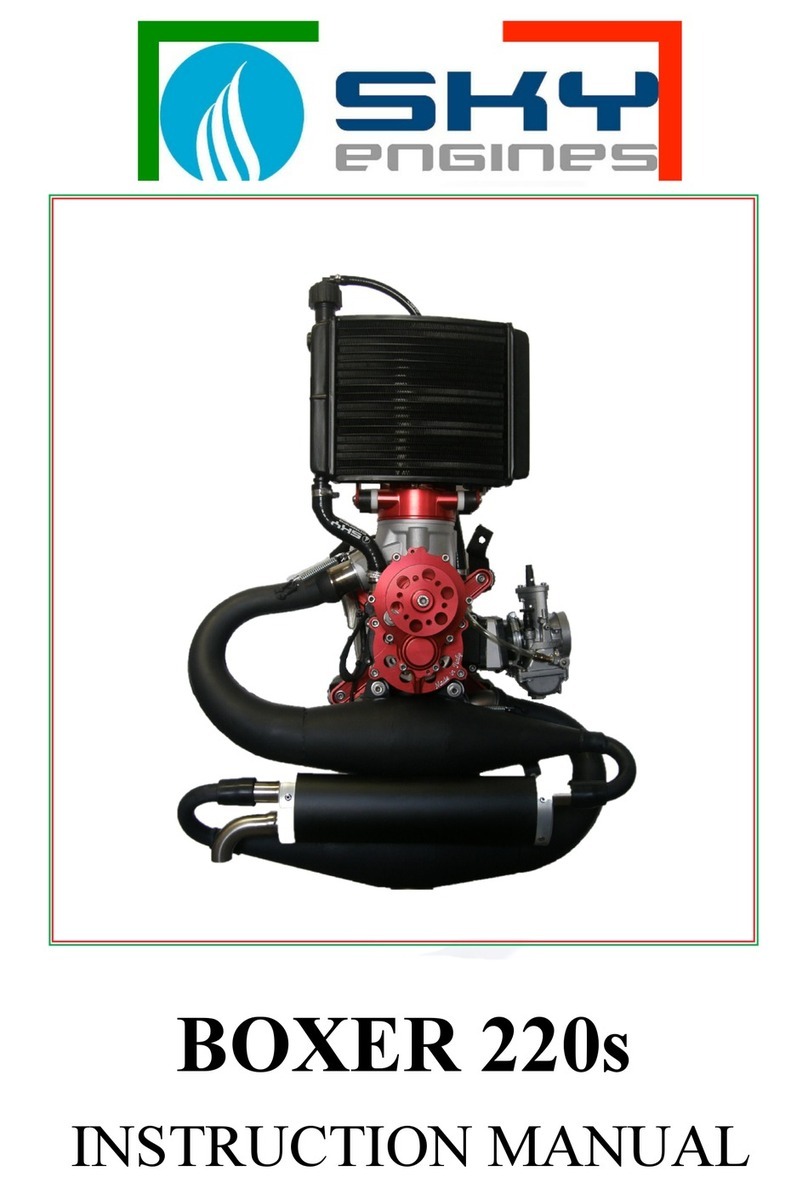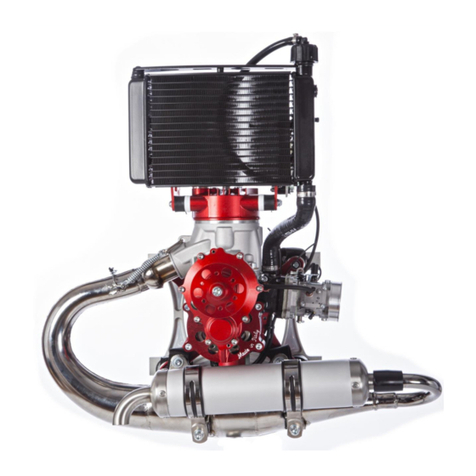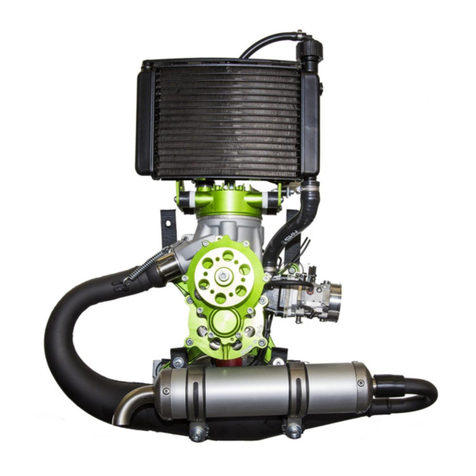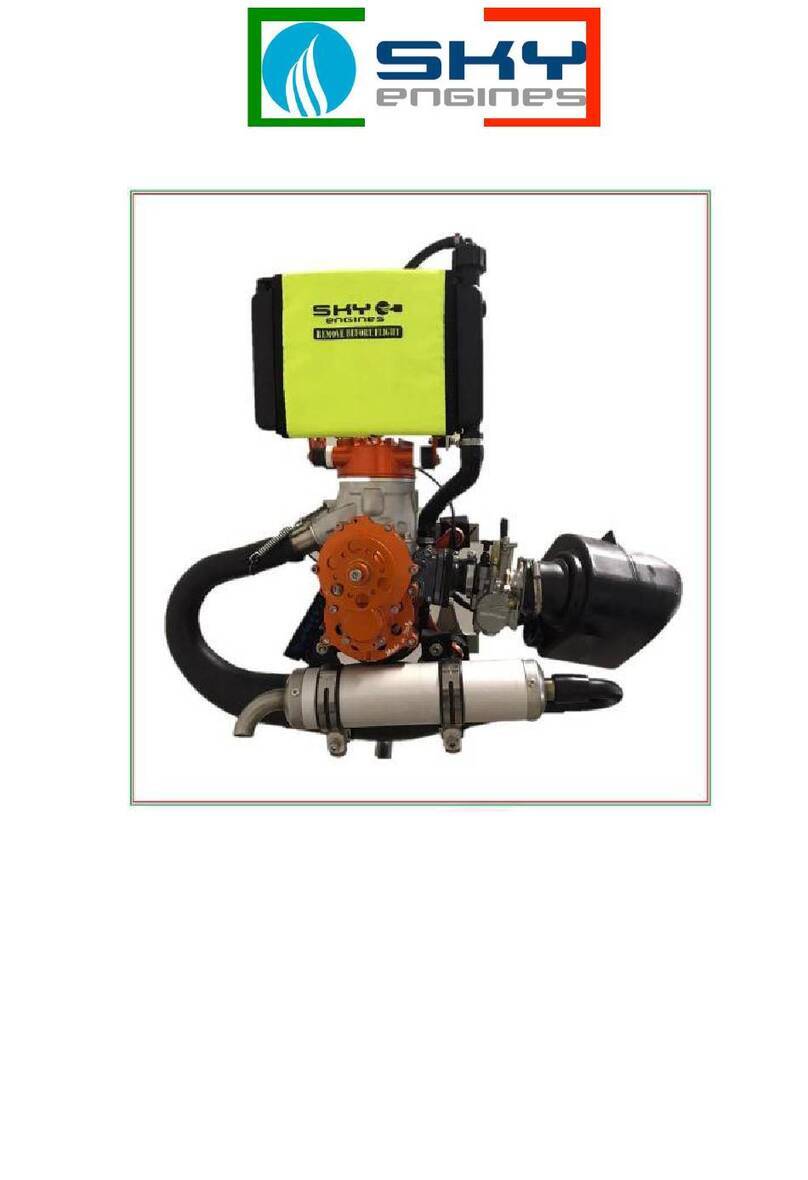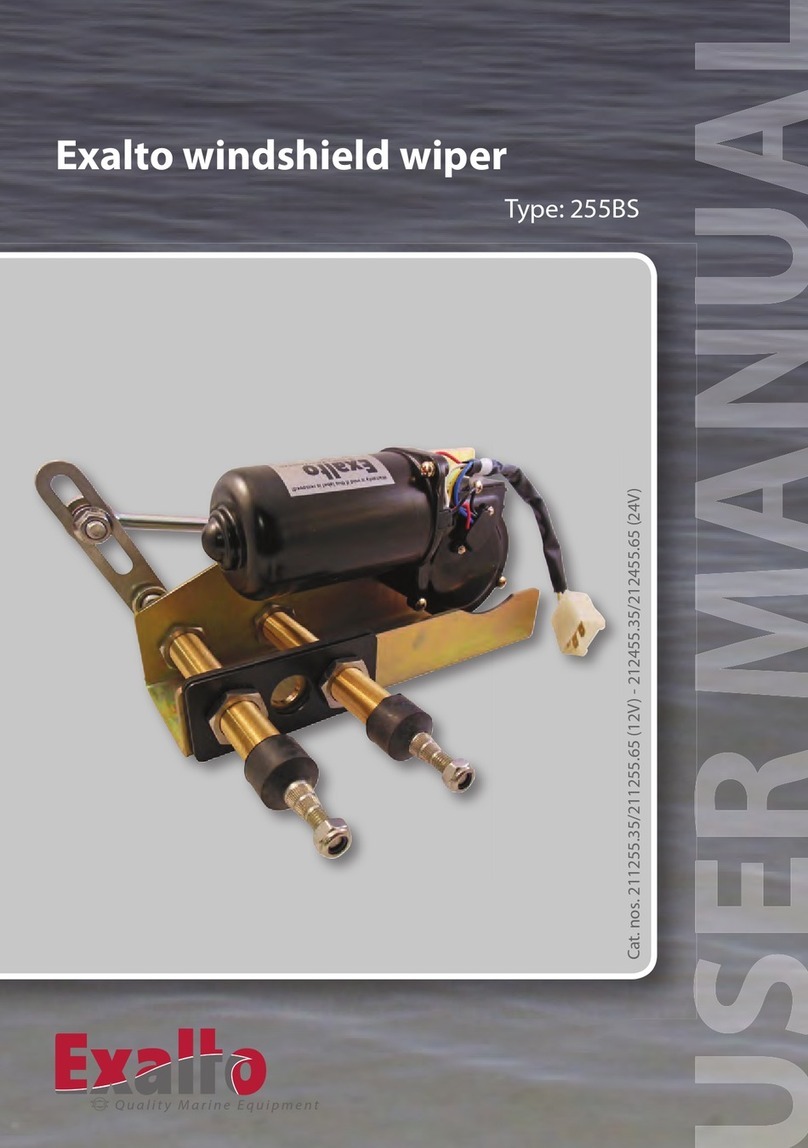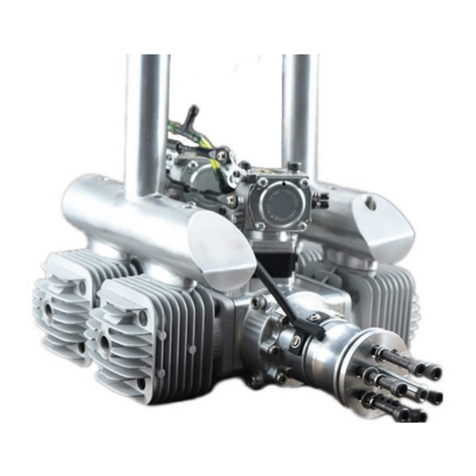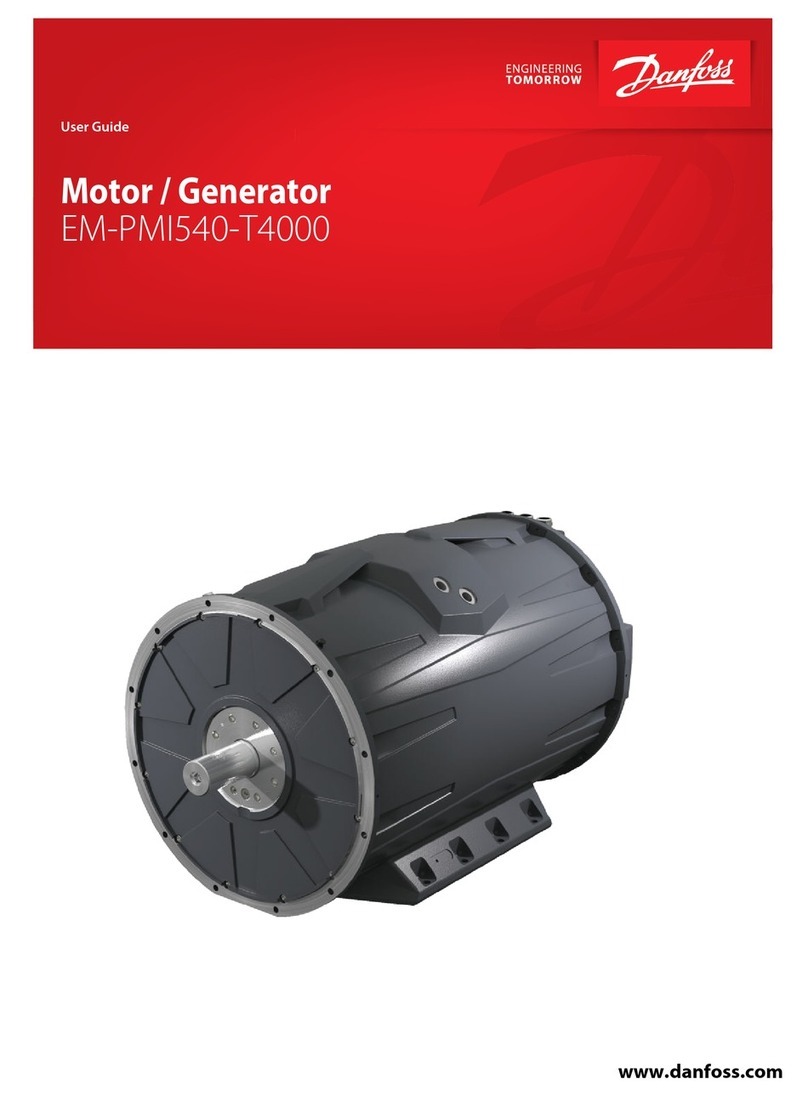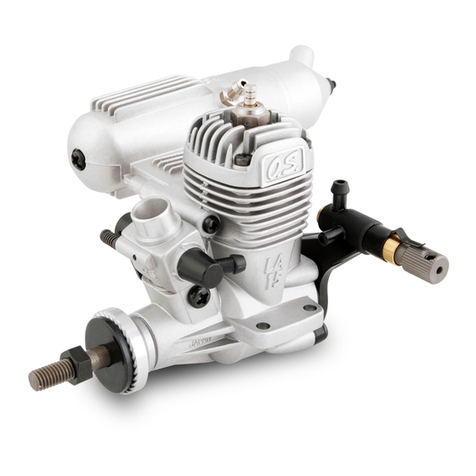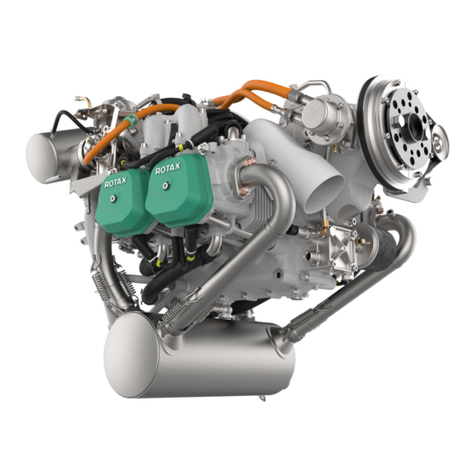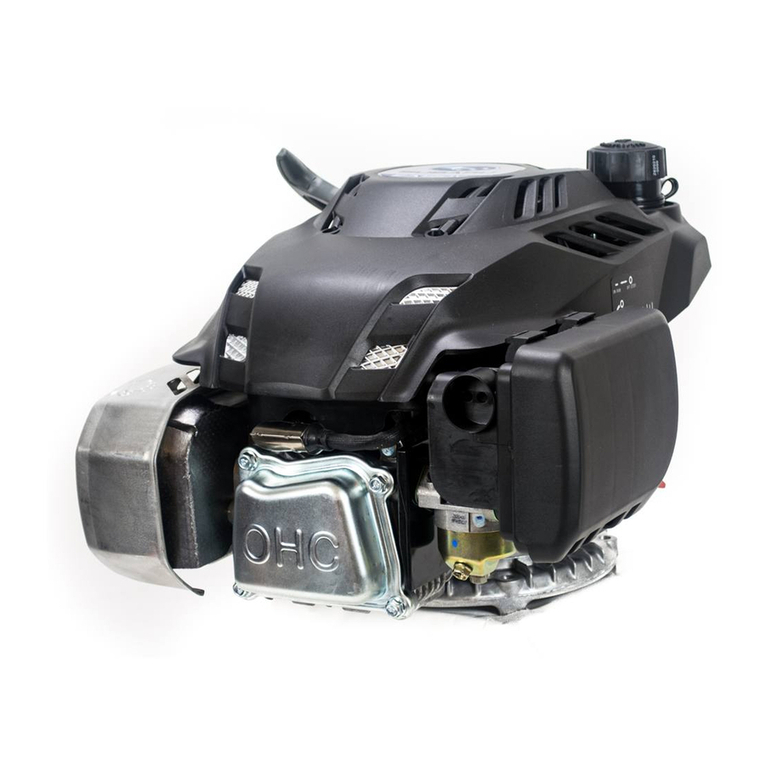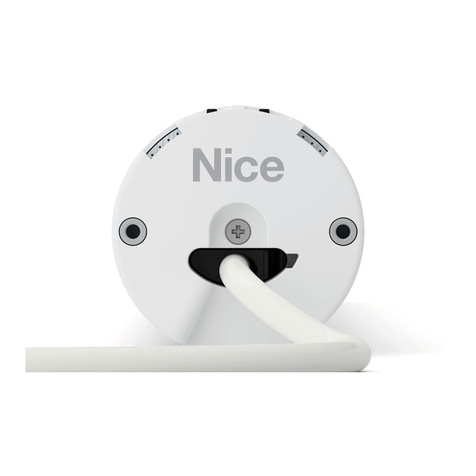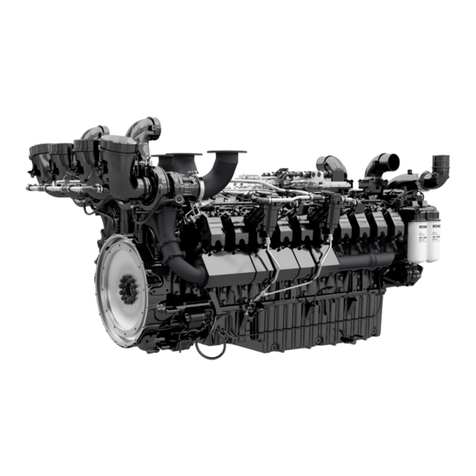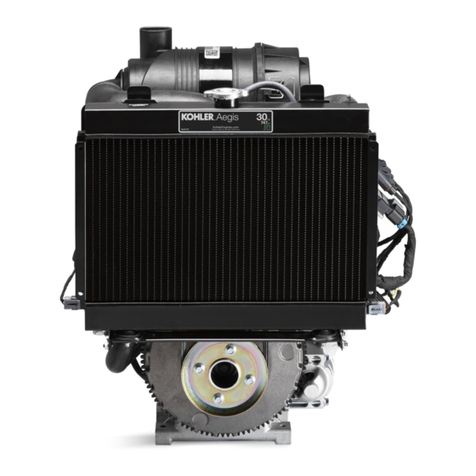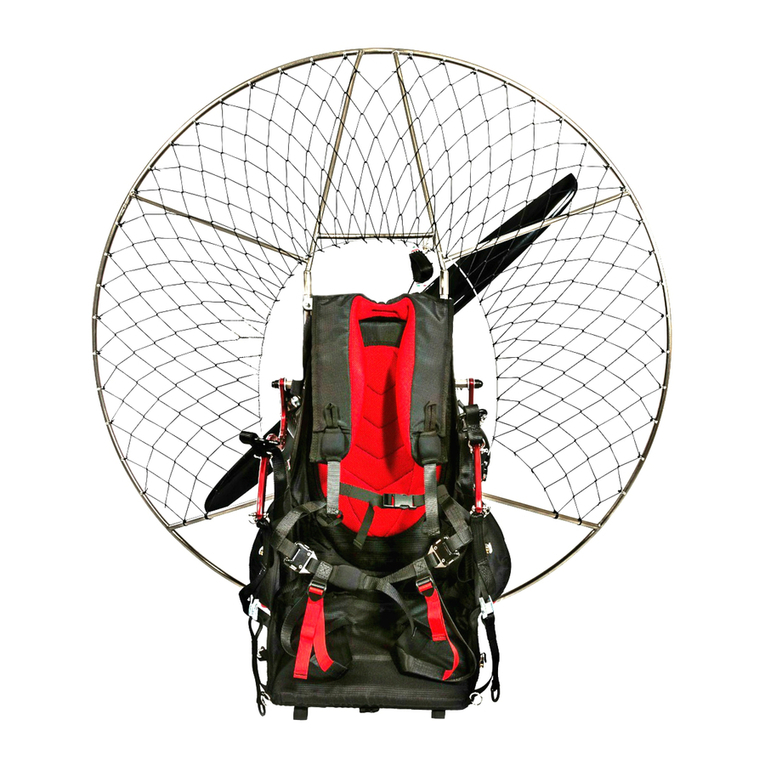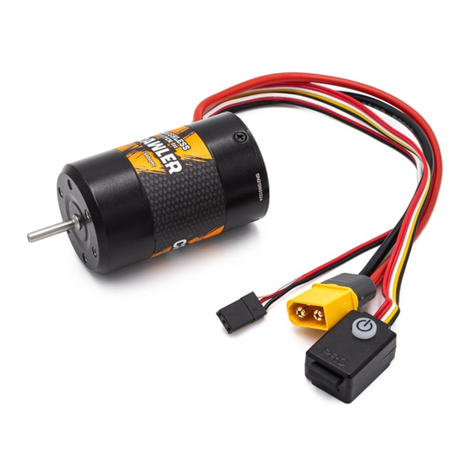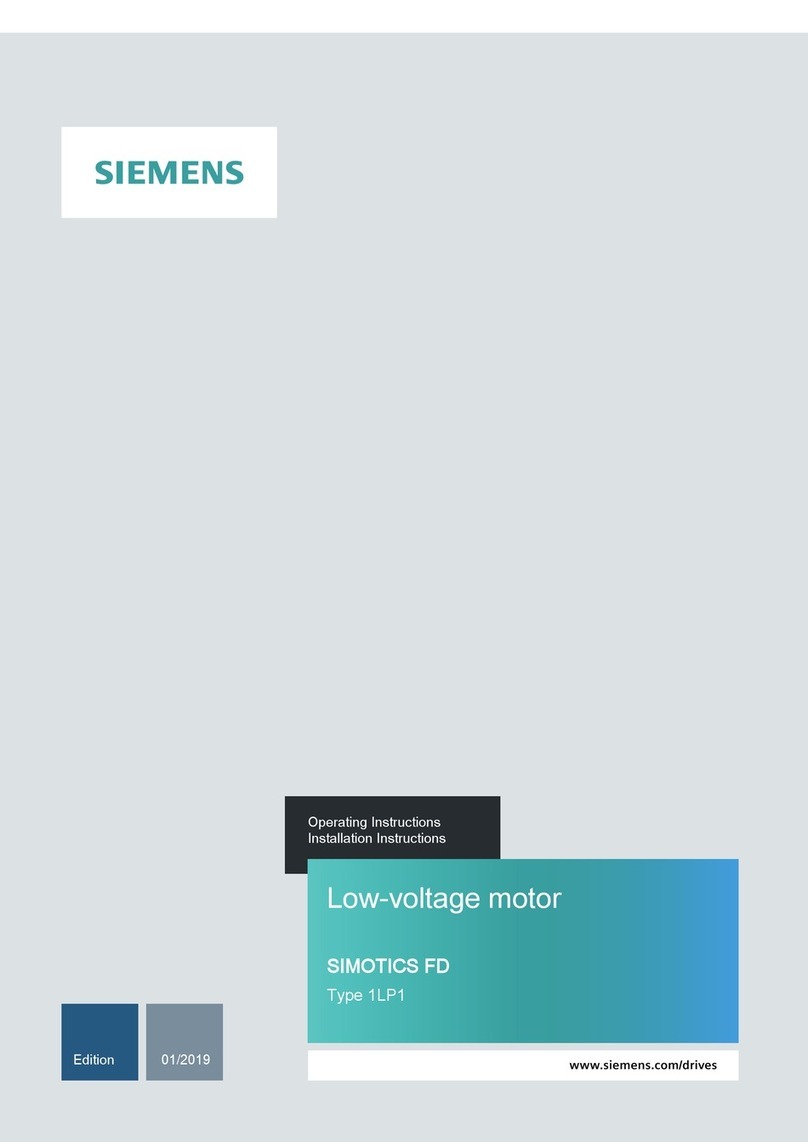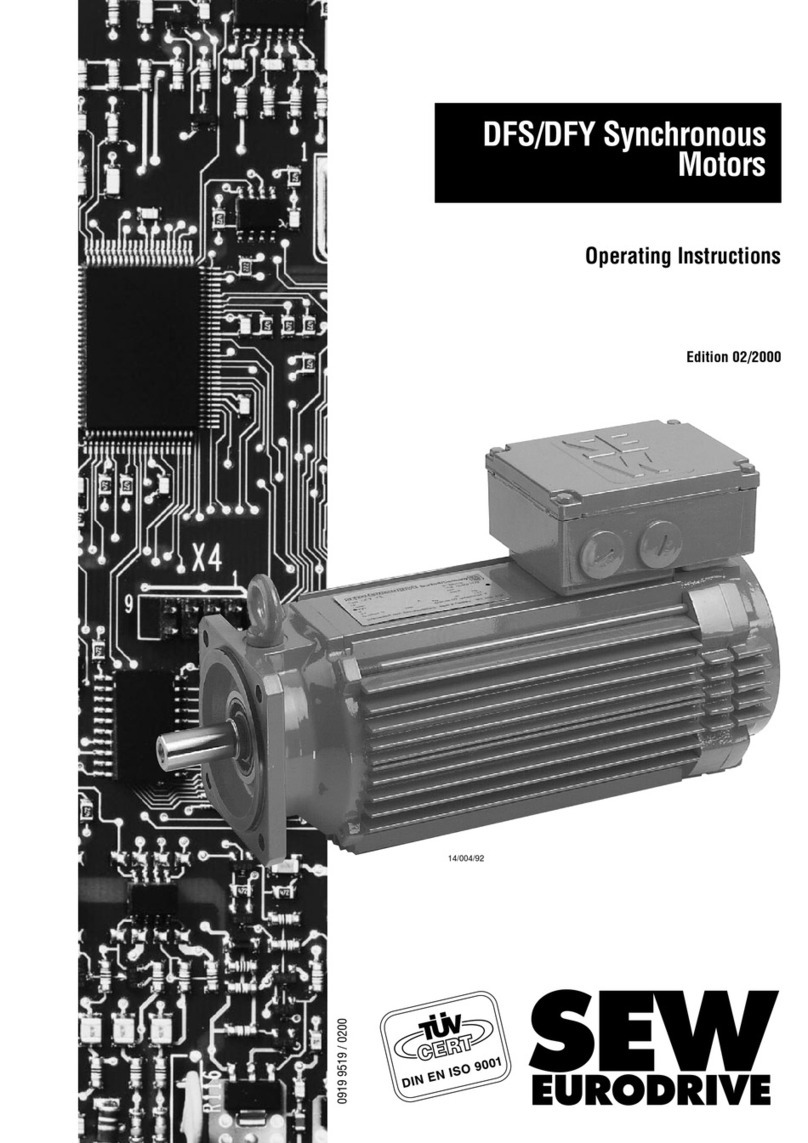SKY Engines SKY 100 User manual

SKY 100
User’s Manual

INDEX
1.0 INTRODUCTION
•
1.1 General warnings
•
1.2 Recommendations for the prevention of accidents
2.0 DIRECTION FOR USE
•2.1 Fuel
•2.2 Running - in
•2.3 Starting the engine
3.0 TECHNICAL SPECIFICATIONS
•3.1 Engine illustration
•3.2 Technical specifications
•3.3 Assembly of secondary components
•3.3.1 Special assembly instructions
•3.3.2 Radiator
•3.3.3 Muffler
•3.3.4 Clutch
•3.3.5 Starter
•3.3.6 Rods and silent block
•3.3.7 Silencer
•3.3.8 Laminar bundle
•3.3.9 Carburetor
4.0 MAINTENANCE
•Cleaning
•Topping up liquids
•Adjustment
•Schedules and general recommendations
5.0 SPARE PARTS
6.0 WARRANTY
•Requirements
•Warranty Certificate

1.0 INTRODUCTION
Thank you for purchasing a SKY100 engine, developed and manufactured by SKY
ENGINES.
WE ADVISE YOU TO CAREFULLY READ THIS MANUAL AND FOLLOW ALL THE
MAINTENANCE INSTRUCTIONS GIVEN BELOW BEFORE USING THE ENGINE IN
ORDER TO AVOID SEVERELY DAMAGING IT.
If you require more information, have queries or need to purchase spare parts, please
contact us byphone or e-mail using the contact details printed on the cover.
We thank you for the attention, wish you the best of fun and hope you are satisfied
with yourpurchase.Best regards,
Sky Engines s.r.l.
1.1 GENERAL WARNINGS
• SKY ENGINES shall not be directly or indirectly liable for the use of the engine,
especially if it is altered or tampered with by third parties.
• MAINTENANCE IS ESSENTIAL to avoid severely damaging the engine.
Therefore, we advise you to CAREFULLY read Chapter 4.0 of this manual and
thoroughly follow all the instructions. For information on damaged spare parts,
see paragraph 3.3, which illustrates the assembly procedures for all the secondary
components that tend to deteriorate in time.
• SKY ENGINES shall not be liable for damages caused by an inaccurate
maintenance or incorrect assembly, except for the replacement of components
covered by the warranty.
• The engine has a maximum capacity of 90-100 Kg, which means that it is able to
transport a person with a maximum body weight within these parameters. The use of
the engine to transport heavier weights may cause problems to the trimming.
• It is advisable to perform all the inspections required in order to verify that the
engine is safe and in good working order before flying.
• Technical alterations made by the user, though permitted, are full responsibility of
the user. Spare parts used for said alterations shall not be covered by warranty.

• Alterations carried out by the user or the removal of original spare parts may
jeopardize the safety of the engine..
• SKY ENGINES reserves the right to change models and/or catalogues without
warning and without any whatsoever obligation. Further information is provided on
Web site www.skyengines.com
• Aircraft driven by this engine must be used in open spaces only and in areas
reserved for these activities. The user must be aware of all the hazards connected
with the use of this engine and be aware of the fact that it may accidentally switch off.
• For detailed information on the warranty terms, see Chapter 6.0 in this manual
1.2 RECOMMENDATIONS FOR THE PREVENTION OF ACCIDENTS
As the use of this engine can be very dangerous, it is important to adopt all the
necessary precautions both during, before and after the flight in order to avoid severe
accidents.
We advise you to follow the general precautions illustrated below in order to avoid
damages or accidents.
• As the engine does not solve all flying problems, it is important to avoid risky moves.
One of the most common mistakes is flying above areas that do not allow you to land
at very low heights. It is always important not to underestimate the possibility of faults
and the need of having to make an emergency landing.
• Always take into account that the lack of thrust of the engine may affect the flight
stability.
- Pay particular attention to swinging movements caused by the change of trimming
that cause falls of 4-5 meters.
- As the engine could switch off at any time, it is important to make sure you are able
to perform an emergency landing if required.
• ALWAYS avoid flying above water for your own safety and in order not to damage
the engine.
WARNING!!
This is not a certified engine!
It is intended to be used for experimental and not certified engines.

2.0 DIRECTIONS FOR USE
The directions for use provided in this manual refer to models available at the time of
print. Although the manufacturer is not obliged to provide updates on changes, users
may request specific information on the upgrade of single products. For more
information, visit Web site www.skyengines.com.
2.1 FUEL
SKY100 is a 2 stage engine that employs
a mixture of fuel and oil.
Always remember that a correct
carburetion and fuel mixing are essential
to prevent the seizure of pistons fitted on
2 stage engines, which are not covered by
warranty.
ATTENTION!!
MIX FUEL AND OIL WITH A 3% RATIO
USING PREMIUM QUALITY SYNTHETIC
OIL FOR 2 STAGE ENGINES.
Always check the amount and presence of
oil
as THE LACK OR EXCESSIVE
AMOUNTS
COULD DAMAGE THE ENGINE.
WARNINGS!!!
FUEL IS EXTREMELY
FLAMMABLE AND EXPLOSIVE.
ALWAYS PERFORM REFUELING
OPERATIONS OUTDOORS, IN AN
ADEQUATELY VENTILATED AREA AND
WHEN THE ENGINE IS NOT RUNNING.
DO NOT SMOKE CLOSE TO FUEL AND
DO NOT STORE IT IN AREAS WHERE
IT COULD BE EXPOSED TO SPARKS
OR FREE FLAMES. KEEP THE FUEL
OUT OF THE REACH OF CHILDREN.
ATTENTION!!
NEVER MIX DIFFERENT TYPES OF
OILS.
°Only use100% BARDAHL KTS synthetic
oil.
INTERVAL OF
TIME OIL PERCENTAGE
BREAK - IN
SUBSEQUENT
PERIOD
3%
2,5 %

A good breaking-in ensures a long life of the engine and enhances the performance
of its components.
Use the engine very carefully during the first 3 hours of flight.
Do not use the engine at maximum power for extended intervals of time.
Do not keep the accelerator in the same position for several seconds; in this case it is
preferable to open and close the accelerator without increasing the elevation in order
not to force the engine
Use the engine for 10 minutes at a time, then allow it to cool.
Repeat the same operations every time you check the engine.
THE BREAK-IN PERIOD CAN BE CONSIDERED COMPLETED AFTER 3 HOURS
OF FLIGHT OR THE USE OF 10 LITERS OF FUEL!
2.3 STARTING THE ENGINE
SKY100 engine is started by a manual starter. It must strongly pull the rope and
avoid to flooding the engine.
2.2 RUNNING - IN
WARNINGS!
• The exhaust gases of the engine
contain carbon monoxide, which can cause
death. DO NOT START THE ENGINE
INDOORS. ALWAYS VERIFY THAT THIS
OPERATION IS PERFORMED OUTDOORS IN
ADEQUATELY VENTILATED AREAS.
• Always start the engine after it has
been completely assembled as the lack of
some components could cause severe
damage.
• Always handle the propeller with
utmost care at it may reach very high
speeds to the point of becoming hardly
visible. Always maintain a safety
distance.
If the engine is cold, always wait
a few minutes after start-up to
heat the engine and accelerate
at regular intervals to avoid
damaging it.

3.1 FIGURE OF THE ENGINE
1: CYLINDER SK006 11: IGNITION COIL SK033
2: RADIATOR CAP SK013 12: MUFFLER SK040
3: RADIATOR SK010 13: RADIATOR’S HOSES SK011/012
4: LAMINAR BUNDLE SK021/24/26 14: DRAIN RESERVOIR SK014
5: MUFFLER SEAL SK043 15: RADIATOR RODS SK017
6: HEAD + COVER SK007/08 16: GUARD SK001
7: WALBRO CARBURETOR SK019 17: SPIDER SK032
8: MUFFLER MAINFOLD SK045 18: MANUAL STARTER SK036
9: REDUCTION GEAR SK031 19: SILENT BLOCK SK015/016
10: SILENCER SK041

3.2 TECHNICAL SPECIFICATION
TYPE SINGLE-CYLINDER 2 STAGE ENGINE WITH LIQUID
COOLING
SWEPT VOLUME:
102 CC
MAX POWER 18 HP @ 10200 RPM
MAX. RATED
SPEED: 10600 RPM
BORE 55 mm
STROKE 43 mm
REDUCTION MECHANICAL 1:4 OIL LUBRICATED
THRUST: 60 Kg WITH THREE 220 cm VANES @10400 RPM
CARBURETOR WALBRO WG8
TOTAL WEIGHT: WITH LIQUIDS 13 Kg
EGT: 700 °C
CHT: 170°C
MAX COOLANT
TEMPERATURE: 95°C
MAXIMUM
CAPACITY: MAXIMUM WEIGHT OF USER: 90-100 Kg
CLUTCH DRY CENTRIFUGAL
WARNINGS!
The general recommendations included in the Technical Specifications sections are
very important to prevent severe damage to the engine and for the safety of users.
ALWAYS FOLLOW THE INSTRUCTIONS GIVEN ABOVE AND DO NOT EXCEED
THE MAXIMUM VALUES SPECIFIED.
SKY ENGINES SHALL NOT BE LIABLE FOR INJURIES TO PEOPLE OR
DAMAGES TO PROPERTY ARISING FROM THE FAILURE TO FOLLOW THE
AFOREMENTIONED TECHNICAL SPECIFICATIONS.

3.3 ASSEMBLY OF SECONDARY COMPONENTS
3.3.1 SPECIAL ASSEMBLY INSTRUCTIONS
Engine SKY100 is more complex than other models and a greater experience is
therefore required to assemble its components and specifically its internal ones. As
the engine is liquid cooled, the assembly of the components that use the radiator's
coolant requires the implementation of specific tasks that only a skilled mechanics is
able to carry out.
Therefore, all users who are not specifically skilled or trained to perform these
operations SHOULD NOT TOUCH THE ENGINE EXCEPT FOR ORDINARY
MAINTENANCE OPERATIONS, WHICH SHOULD BE PERFORMED FOLLOWING
THE DETAILED INSTRUCTIONS SPECIFIED BELOW. DO NOT IMPROVISE OR
ATTEMPT TO MAKE UNAUTHORIZED CHANGES THAT COULD DAMAGE THE
ENGINES NOT COVERED BY WARRANTY.
• Unauthorized changes could make the engine highly unstable!
• Replace the components of the engine with original SKY ENGINES spare parts to
guarantee a reliable operation.
3.3.2 RADIATOR
Assemble the silent
blocks on the radiator,
then fit the whole
assembly on the radiator
rods.
Threads tubes 1, 2, and 3 in the
corresponding inlets a, b, c of the
radiators. Carefully check the position of the fittings
on the tube clamps straps and make sure
that they have been applied as shown in the
photo.

3.3.3 MUFFLER
Apply sealant glue to the manifold of the
muffler, then position the muffler on the
manifold close to the glue layer, firmly
pushing the pipe union on the manifold.
Firmly tighten the fittings of the muffler with the
silent blocks of the engine frame using two M8 TCCE
screws and washers.
Insert the springs between the
hooks of the muffler and those of the
manifold.
Thread the steel cable between the
hooks that keep the springs in place,
insert it between the springs and fix
them on the side of the manifold, as
shown in the photo.

3.3.4 CLUTCH
Unscrew the nut of pad’s pin by
an 8 mm wrench.
Remove the pin (squeeze pads to better
extract it)
In the new pad, unscrew
completely the dowel and put the
spring in his site (greater diameter
into body clutch).
After reduction’s unmounting, unscrew the
center nut by a pneumatic or manual
wrench (in the second case block
crankshaft rotation).
Remove the washer.

Squeeze the pad (as in unmounting case) to center holes (It could be
useful to use a little tube) and put in the pin.
Use a medium force screw blocker,
replace the washer and tighten the nut
(it is normal that washer could move a
little)
Put some medium force screw
blocker on the registration dowel and
tighten it.

Adjust dowel to have a little space
between pad and clutch when you
try to open it.
It’s the same for the other
Mount clutch on crankshaft without
forcing a lot.
Reassemble washer and nut.
If you need to tune up clutch, it is
possible to adjust dowels by a wrench
in carter’s holes without unmounting
clutch.
NOTE:
Tightening dowels, you have a smaller opening of pads, releasing them, you have a
faster contact of pads on bell housing.

3.3.5 STARTER
Remove the cover from the manual
starter loosening the screws in a
crossed
pattern.
Loosen the wire reel and remove it
from the cover. Then, loosen the handle
and remove the wire reel from the spring.
Remove the worn wire from the side
hole of the wire reel and replace it with a
new one. Knot the end of the wire and
firmly insert the knot into the hole.
To replace the spring, insert the end
side into the cover duct, as shown in the
photo.
Attention! When inserting the spring,
always make sure that the tip of the
spring is facing the channel from which
the wire projects.
Delicately tighten the spring on the
cover, holding it with one hand. Thoroughly lubricate the area in contact
with the spring.
Insert the wire reel and turn the spring
by one revolution.
Loosen the worn
teeth of the
flywheel.
Install the new teeth following
the procedure described in
points 1, 2 and 3.

3.3.6 RODS AND SILENT BLOCK
Install the silent blocks with the Teflon
plate on the rod supports.
Install the rods on the silent blocks.
Install the silent blocks on the rods.
Install the tank as shown in the photo,
slightly tightening the nut until the tip of
the screw is visible.
Install the radiator on the silent blocks.

3.3.7 SILENCER
Loosen the small bolts that join the
manifold to the base of the maffler.
remove the base of the pipe.
remove the pipe while maintaining in
place the manifold muffler.
remove the old glass wool
couple the new glass wool
fold the glass wool
in its original
configuration,
reinsert the pipe
and tighten the
manifold as
described above

3.3.8 LAMINAR BUNDLE
3.3.9 CARBURETOR
Insert the Teflon plate and
the laminar bundle. Repeat
this operation for all
surfaces.
Install the Walbro plate above
the laminar bundle.
Install the ring and the
Walbro carburettor on the
small plate using M 6 x 50
screws.
Apply a minimum amount of Sili Motoron the
mouth of the laminar bundle, distribute it
consistently with a finger and verify that there
are no traces of material inside the bundle.
Loosen the Walbro and replace
membranes 1 and 2.screws.

4.0 MAINTENANCE
THIS CHAPTER CONTAINS VERY IMPORTANT INFORMATION. IN ORDER TO
ENHANCE THE LIFE OF YOUR ENGINE AND PREVENTING PROBLEMS CAUSED
BY WEAR, IT IS ESSENTIAL TO CAREFULLY READ ALL THE WARNINGS AND
DATA ON SCHEDULES, AND FOLLOW ALL THE INSTRUCTIONS PROVIDED.
IT IS USEFUL TO REMEMBER THAT DAMAGE ORIGINATING FROM AN
INSUFFICIENT MAINTENANCE ARE NOT COVERED BY THE WARRANTY.
4.1 CLEANING
SKY100 engines do not require specific cleaning operations. However, when
performing this operation, always remember not to use corrosive solvents on the
external or internal parts of the engine.
ALWAYS KEEP THE INTERNAL PART OF THE ENGINE CLEAN TO PREVENT
RESIDUALS FROM ENTERING THE INTERIOR OF THE CYLINDER OR, WORST
STILL, THE GUARD AND CAUSING THE SEIZURE OF THE ENGINE.
✴When using a filter box, always remember to disassemble it and wash the internal
filter with water and a degreasing detergent after approximately 100 hours of flight.
Cleaning the muffler does not improve the performance of the engine, but only the
quality and quantity of exhaust emissions. Customers who prefer not to hear so much
noise while flying should carry out the maintenance operations described in the
chapter above with a frequency of at least 50 hours of flight for an optimum operation
of the muffler.
4.2 TOPPING UP LIQUIDS
The only liquids that need replacing are:
RADIATOR COOLAN THE LEVEL OF THE RADIATOR COOLANT MUST BE
INSPECTED APPROXIMATELY AFTER 10 HOURS OF FLIGHT BY PERFORMING
THE FOLLOWING OPERATIONS:
1. Loosen the RADIATOR CAP.
2. Verify that the liquid inside the radiator reaches the side nut next to the cap.
3. If the liquid level is below the indicator, top up the radiator coolant as specified
above.
4. When replacing the whole amount of coolant, always remember not to exceed the
amount of 700 ml:
- 600 ml directly in the radiator
- 100 ml in the recovery tank

ATTENTION!
COOLANT MUST ALWAYS BE TOPPED UP WHEN
THE ENGINE IS COLD!!!
WHEN PERFORMING THIS OPERATION, ALWAYS
REMEMBER TO POUR THE LIQUID INTO THE
RADIATOR AND NOT INTO THE SMALL CONTAINER,
AS THE LATTER IS DESIGNED TO BE USED TO
COLLECT THE COOLANT IN EXCESS, NOT TO FILL
THE RADIATOR. THE LIQUID IN EXCESS MAY EXIT
FROM THE SMALL TANK.
IF LEAKS ARE VISIBLE, ALWAYS THOROUGHLY
CHECK THE SMALL TANK AND VERIFY THAT THE
COOLANT DOES NOT EXCEED THE
RECOMMENDED LEVEL.
THE SMALL TANK MUST BE FILLED UP TO THE
INDICATOR WITH THE BLACK "MAX" WORD
SITUATED ON THE EXTERNAL SIDE, AS SHOWN IN
THE PHOTO.
ALWAYS REMEMBER NOT TO FILL THE SMALL
TANK ABOVE THE MAXIMUM LEVEL AS THIS
COULD CAUSE LEAKS.

REDUCTION GEAR OIL:
1. REGULARLY INSPECT THE OIL LEVEL IN THE REDUCTION GEAR
USING THE BUSHING ON THE FRONT SIDE.
2. REPLACE THE WHOLE AMOUNT OF OIL AFTER APPROXIMATELY
100 HOURS OR IF YOU NOTICE THAT THE BUSHING IS PLACED
IN PERFECT VERTICAL POSITION.
3. OPEN THE BUSHING AND INSERT 30 ml OF SYNTHETIC OIL OF GEARS.
✴Our technician recommend Bardahl SAE 75W-90 synthetic oil
4.3 ADJUSTMENTS
The only adjustment that may enhance the operation of the
engine is the regulation of the maximum and minimum level
of the carburetor:
STANDARD ADJUSTMENT:
- OPEN INDICATED SCREW BY A QUARTER OF
REVOLUTION (3)
4.4 SCHEDULES AND GENERAL RECOMMENDATIONS
This paragraph lists a few recommendations that have been defined as a result of the
tests carried out by our mechanics and on the basis of the feedback provided by
customers. We kindly ask you to report anomalies or maintenance procedures that
are not described in this manual using the space provided in chapter 7.0. You can
also use this space for feedback or queries, to which we will be glad to answer.
Table of contents
Other SKY Engines Engine manuals
